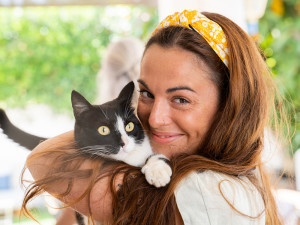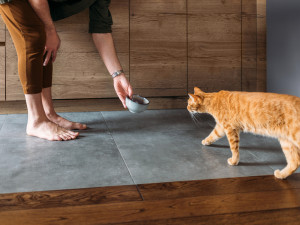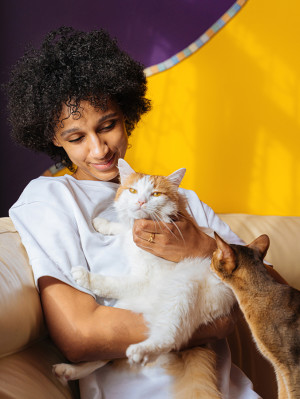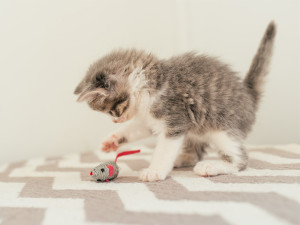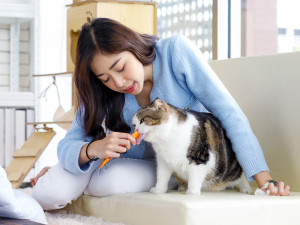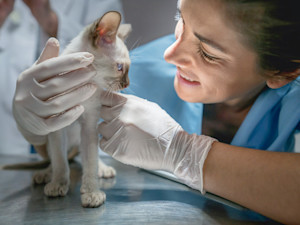What is The 3-3-3 Rule For Cats?
Why your cat doesn't love you yet... but might eventually
If you’ve ever adopted a cat and thought, “Why won’t they love me like I love them?” – congratulations, you’re not alone, and you’ve also discovered the hard truth that cats don’t do instant gratification.
Enter the 3-3-3 rule, which is not a ‘rule’ so much as a simple but super useful guideline about how to help your cat settle into a new home. It was originally popularised in dog rescue circles, but is now widely used to help pet parents with feline adoption too (with a few tweaks for our less cooperative companions).
What is the 3-3-3 rule for cats?
The 3-3-3 rule breaks down the first critical months of your adopted cat’s journey into three stages:
3 days to decompress
3 weeks to start adjusting
3 months to feel fully at home
While academic studies validating the 3-3-3 rule for cat adoption are limited, the concept aligns with established principles in animal behaviour and welfare and is a widely accepted framework used by by rescue centresopens in new tab, charitiesopens in new tab and behaviourists to guide adopters through the initial adjustment period for a new cat.
This guideline is based on observations and best practices and it’s a great reminder that for a cat, adjusting to a new home takes time, patience and a fair amount of Dreamies.
And while some cats settle in faster (especially if they’re young or very chill), for others it might take longer. The rule is meant to guide expectations – not set deadlines.
The first 3 days – fight, flight or freeze
The first few days after you bring your cat home are all about survival – emotionally, at least. Common behaviours during this time include:
Hidingopens in new tab in impossibly tiny places.
Refusing to eatopens in new tab, drinkopens in new tab or use the litter trayopens in new tab.
Flattened earsopens in new tab, wide eyes, low tail positionopens in new tab – aka full-on panic mode.
Hissingopens in new tab if approached too quickly.
The reason behind these behaviours is a result of sudden environmental changes, which are among the top stressors for felinesopens in new tab. Unlike dogs, cats don’t have a pack to rely on – they’re territorial loners by nature. Your home is now unfamiliar terrain and their instincts are telling them to tread very carefully.
What you can do to help
Give them a dedicated ‘safe room’ with all their essentials (litter tray, food, water, hiding spots).
Don’t force affection – let them come to you when ready.
Sit quietly nearby and read, scroll or binge your favourite series to get them used to your presence.
The next 3 weeks – building trust and settling in
Now that your cat has realised they aren’t in immediate danger, they’ll begin cautiously exploring their new kingdom. This is when they start testing boundaries, watching your every move like a judgemental flatmate. You may notice:
Increased curiosity – sniffing new rooms, objects – and possibly you.
Eating regularly (bonus if they start demanding food with a well-timed meow).
Learning your daily routine and reacting to it (sitting near the door when you come home).
Tentative playopens in new tab or interactive behaviour.
According to a studyopens in new tab, most cats take between two to four weeks to begin exhibiting ‘settled’ behaviour after being rehomed, especially if they were previously in a shelter environment.
So these three weeks count as a critical bonding phase for you and your new feline friend. There a number of ways to build connection with your cat.
Gentle play
All cats need play. Even cats who seem like they couldn’t care less. It strengthens the human-animal bond, keeps cats active and in better shape, and can improve relationships between cats and other pets in the home – especially if they all play together.
Also, cats that are played with regularly are much less likely to exhibit behavioural issues such as excessive meowingopens in new tab and aggression. “Play helps satisfy a cat’s natural need to hunt,” says cat behaviourist Cristin Tamburoopens in new tab. “In the wild, feral cats spend up to 50 percent of their day hunting, and many of those same actions and behaviours are also seen during play. While many domestic cats spend most or all of their time indoors and rarely or never actually hunt, the instinct is still very much hardwired.”
To play with your cat, first, get some toys. “Like humans, cats can have different preferences,” says Tamburo. “Some are more interested in toys they can chase, while others prefer puzzle feeder-type toys. Many cats also enjoy wand toys or those they can wrestle with.“
Tamburo also recommends using catnipopens in new tab to stimulate play. “Up to 70 percent of cats respond to catnip or catnip toys,” says Tamburo. “So spraying the toys with a catnip spray can help entice them.” Also, keep in mind that some cats can be hesitant of new things, so go slow. Set the toy down and let your cat check it out and get used to it before you start waving it around.
Slow blinks and soft talking to build trust
The slow blinkopens in new tab is just what it sounds like: a leisurely closing and opening of the eyes. Think of it as the feline version of a gentle, welcoming smile. It’s also one of the few ways that we, as humans, can communicate with cats in their own language. “The slow blink is a sign of trust,” says Tamburo. “Your cat is showing that they are relaxed and comfortable in your presence.”
According to a recent studyopens in new tab by Professor McComb and Dr Tamsin Humphrey at the University of Sussex, cats are more likely to slow blink at their human if their humans slow blink at them first. They are also more likely to slow blink at slow-blinking strangers than those who just stare at them neutrally, and were generally much more likely to approach people who slow blinked at them first, whether they knew them or not.
“When I’m working with fearful cats or cats who do not know me, I always use the slow blink method to try and signify to them that I am not a threat,” says Tamburo.
“It’s a great way of enhancing the bond you have with cats,” says Professor Karen McComb, PhD, who studies animal behaviour at the University of Sussex. “Try narrowing your eyes at them as you would in a relaxed smile, followed by closing your eyes for a couple of seconds. You’ll find they respond in the same way themselves and you can start a sort of conversation.”
Hand-feeding treats for positive association
Unlike dogs, cats don’t tend to fawn over whoever fills their bowl. So if you’re looking to win the trust of your new feline flatmate, hand-feeding treats can be a surprisingly effective strategy. It isn’t just about bribery (although let’s not pretend chicken-flavoured Dreamies don’t work wonders). When you offer a treat directly from your hand, you’re establishing a positive association between yourself and something your cat enjoys. This taps into a principle known as classical conditioningopens in new tab – a learning process regularly used in animal training. In short, your cat begins to associate your presence, smell and voice with the warm, fuzzy feeling of reward.
Over time, this kind of interaction builds trust and familiarity, particularly in shy or previously mistreated cats. They learn that not only do you bring the snacks, but that you’re safe to approach, sniff and eventually snuggle with.
Hand-feeding also helps encourage gentle physical interaction without overwhelming them. The act of stretching their head forwards to take a treat from your palm is a voluntary gesture of trust. For nervous or newly adopted cats, this can be a huge step – especially when paired with a soft voice and a relaxed posture.
Even brief moments of nose-to-hand proximity help reinforce non-threatening social cues. A 2017 study published in Behavioural Processesopens in new tab found that cats respond more positively to humans who use slow blinks and a non-direct approach, both of which pair beautifully with hand-feeding moments. It��’s a way to introduce structure and consistency to human interaction – small, manageable moments where the cat remains in control but gains something pleasurable from contact.
The 3-month milestone – home is where the cat is
Three months in, if all has gone well (and you haven’t tried to dress them in outfits), your cat will be feeling much more secure, confident, and – dare we say it – loving.
You might now notice:
Seeking you out for affection and cuddles.
Playfulness, purringopens in new tab, increased vocalisation.
Full relaxation postures – like flopping on to their side or belly.
Following youopens in new tab from room to room like a very quiet furry stalker.
This is when their true personality emerges. Are they a chatty Cathy? A loafing introvert? A chaotic gremlin who exists purely to ruin plantsopens in new tab? Whatever they are – this is their authentic self.
Now is a great time to:
Introduce new enrichment (cat treesopens in new tab, window perchesopens in new tab, etc).
Begin clicker trainingopens in new tab or gentle handling.
Slowly start introducing other petsopens in new tab or visitors – if applicable.
What about letting my cat outside?
According to Batterseaopens in new tab, how long you leave it before letting your cat outside depends on the cat’s personality and how quickly they settle. You may be tempted to let your new cat outside as soon as possible, but generally it’s best to allow up to 4-6 weeks after you first take them home if they’re a new cat in your life. This will give them plenty of time to settle in their new environment.
The timescale is slightly different for kittens. Battersea would recommends letting your kitten out with supervised access to the outside once they’re about four months old, and have been neuteredopens in new tab, had all their vaccinationsopens in new tab and are fully settled into your home. You should also make sure your kitten seems confident enough in the house first as going outside can be a little daunting to begin with.
Final thoughts – the 3-3-3 rule for cats
The 3-3-3 rule is not actually a rule but a helpful guideline for understanding how cats adjust to a new home: 3 days to decompress, 3 weeks to start settling and 3 months to feel truly at home. Cats may start off wary, withdrawn or downright panicked, but with time, patience and gentle interaction – like slow blinks, play and hand-fed treats – they begin to trust their humans and show their true, delightfully chaotic selves.
Frequently asked questions
What if my cat takes longer than 3 months to settle?
That’s completely normal! The 3-3-3 rule is a general guide – not a deadline. Some cats, especially those with traumatic pasts or shy personalities, may need extra time to fully relax and bond.
Can I speed up the bonding process with my cat?
Not really, but you can support it. Patience, consistency, gentle play, hand-feeding and letting your cat come to you on their own terms are the best ways to build trust.
Should I be worried if my new cat won’t eat or use the litter tray in the first few days?
Mild appetite loss and litter avoidance can be normal due to stress, but if it continues for more than 48 hours, it’s a good idea to consult your vet to rule out medical issues.
Is the 3-3-3 rule scientifically proven?
While it’s not backed by peer-reviewed studies, the 3-3-3 rule is based on decades of observational experience from shelters and behaviourists and aligns well with established feline behavioural science.
Resources
McKamey Animal Center (2022) The 3-3-3 Rule When Adopting a Dog or Catopens in new tab
Cats Protection Managing Cat Behaviouropens in new tab
Humphrey, T., Proops, L., Forman, J. and McComb, K. (2022) ‘The role of cat eye narrowing movements in cat–human communicationopens in new tab’, Journal of Feline Medicine and Surgery, 24(10), pp. e322–e330.
Coile, C. (2022) Cats and Classical Conditioningopens in new tab
Vitale Shreve, K.R. and Udell, M.A.R. (2020) ‘What’s inside your cat’s head? A guide to feline cognition’opens in new tab, Trends in Cognitive Sciences, 24(10), pp. 813–815.
Battersea Dogs & Cats Home Introducing Your Cat to the Outsideopens in new tab
Bradshaw, J.W.S. (2013) The Behaviour of the Domestic Catopens in new tab. 2nd ed. Cambridge: Cambridge University Press


